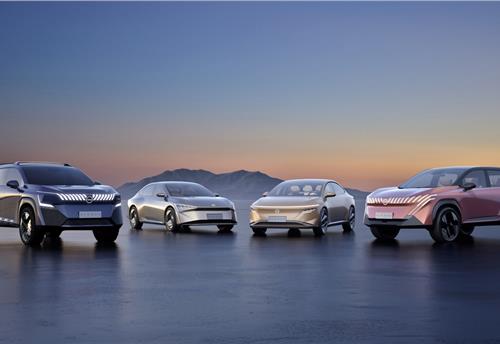EVs are key to greater vehicle efficiency: Global Fuel Economy Initiative
Plug-in electric vehicles (EVs) are well equipped to significantly increase the pace towards greater fuel efficiency, according to the latest GFEI working paper.
Transport drives economic activity and is fundamental to human welfare, but the sector is also a source of greenhouse gas emissions and other forms of pollution, with significant impacts on the environment and human health.
Transport activity is increasing around the world as economies grow, which means that the sector’s emissions are also on the rise. That’s largely because 95 per cent of the world's transport energy still comes from fossil fuels.
UN Environment, which is working to break the link between increased mobility and increased emissions, believes that low-carbon mobility can reduce pollution while also creating jobs, making streets safer, strengthening infrastructure and stimulating local economies.
Planet earth faces a near tripling of the number of vehicles from 2010 to 2050, the vast bulk in emerging economies like India. Improved fuel economy is essential if we are to address some of the negative implications of this growth, such as pollution, congestion, energy and resource depletion, and environmental damage.
Plug-in electric vehicles (EVs) are well equipped to significantly increase the pace towards greater fuel efficiency, according to the latest Global Fuel Economy Initiative (GFEI) working paper.
PEVs also present significant benefits in terms of diversification of the transport energy mix, the reduction of local pollution and greenhouse gas emissions, as well as in facilitating the transition to a clean energy system.
GFEI – a partnership of the International Energy Agency (IEA), United Nations Environment Programme (UNEP), International Transport Forum of the OECD (ITF), International Council on Clean Transportation (ICCT), Institute for Transportation Studies at UC Davis, and the FIA Foundation – has set its target ‘50by30’ to double the average fuel economy of new light duty vehicles (LDVs) globally by 2030 compared to 2005 figures.
This means reducing fuel consumption by 50% (in litres per 100km) and halving carbon emissions in grams of CO2 per kilometre. The target was set in 2010, based on assessments that it could be met using cost effective technologies without full electrification.
However, GFEI partners welcome the swift developments in electric technology since this goal was set, and support the wider roll-out of PEVs to improve vehicle efficiency, which will enable countries to more easily achieve the GFEI target and, ultimately, the climate change targets set in Paris in 2015. PEVs are up to three times as efficient as conventional internal combustion engine (ICE) powered cars, and almost twice as efficient as hybrid car which alternate between the two systems.
The rise in the sales of PEVs has been sharp, rising by a third from 750,000 new vehicles worldwide in 2016, to close to 1 million in 2017. Growth has been driven by a number of factors, including falling battery costs and a shift in policy across the globe:
- China has introduced a new mandate for ultra-low / zero emissions aiming to achieve 12% of all sales (excluding accounting bonuses, which could lower this number) by 2020;
- The European Commission has proposed targets to lower CO2 emissions by 30% between 2021 to 2030, including an incentive system for of low- and zero- emission vehicles to target a 30% market shares by 2030; and
- India has a strong ambition to transition towards EVs by 2030.
Other countries have focused on phasing out new ICE sales - Norway and the Netherlands have a stated ambition to phasing out ICE car sales by 2030 while France and the UK announced similar plans for the year 2040.
Overcoming challenges
The main barriers to PEV market penetration are the purchase cost, the limited availability of models, alongside limitations to the driving range and recharging time. There have been a number of recent developments, with several models now boasting a driving range of 300km or more. Ensuring that charging stations are available for EV owners is also an important consideration, with deployment rates that vary significantly from country to country.
The promising prospects for the PEV market dynamics should not be seen as an alternative to efficiency improvements of the internal combustion engine, but should rather be seen as a complementary instrument to achieve greater vehicle efficiency overall.
The overall benefits of electrification will also need to be supported by a transition to low carbon electricity to ensure that they fully deliver on GHG emission abatements: the transition to sustainable transport needs to take place hand-in-hand with the clean energy transition.
Sheila Watson, Director of Research and Deputy Director of the FIA Foundation, said: “The growth of the electric vehicle market has the potential to boost the efficiency revolution in vehicles which we need to see in our transition towards a greater reliance on low-carbon transport. However, policies that support the uptake of electric mobility only lead to fewer carbon and pollutant emissions if accompanied by renewable energy-based decarbonisation of the electricity sectors – sustainable mobility for all and sustainable energy for all must come together.”
Pierpaolo Cazzola, Analyst at the International Energy Agency, said: “The transition to electric mobility has many positive implications for energy diversification, air quality and GHG emission mitigation, and strong synergies with fuel economy policies. The decision of GFEI partners to support the roll-out of electric vehicles to help reach the GFEI target is good news for sustainable transportation and clean energy”.
RELATED ARTICLES
Kia displays EV5 and Sonet SUVs for Chinese market
Kia has unveiled a number of key models and new technologies for Chinese customers at the 2024 Beijing International Aut...
Nissan targets growth in China, unveils four NEV concepts at Beijing Motor Show
The two EVs and two plug-in hybrids are a joint effort with Nissan’s local partner Dong Feng and aimed to better address...
Lamborghini unveils Urus SE ahead of Auto China 2024
Electric-only range of 60km helps reduce emissions by 80%.





 04 Jun 2018
04 Jun 2018
 3449 Views
3449 Views





 Autocar Pro News Desk
Autocar Pro News Desk




